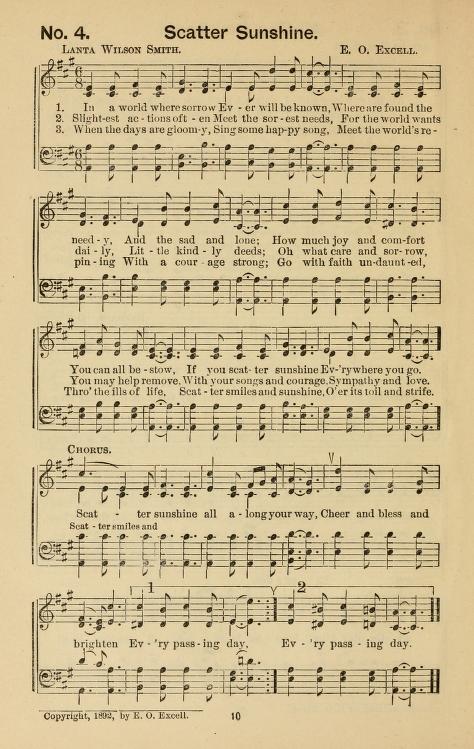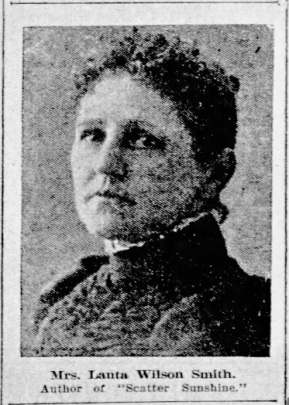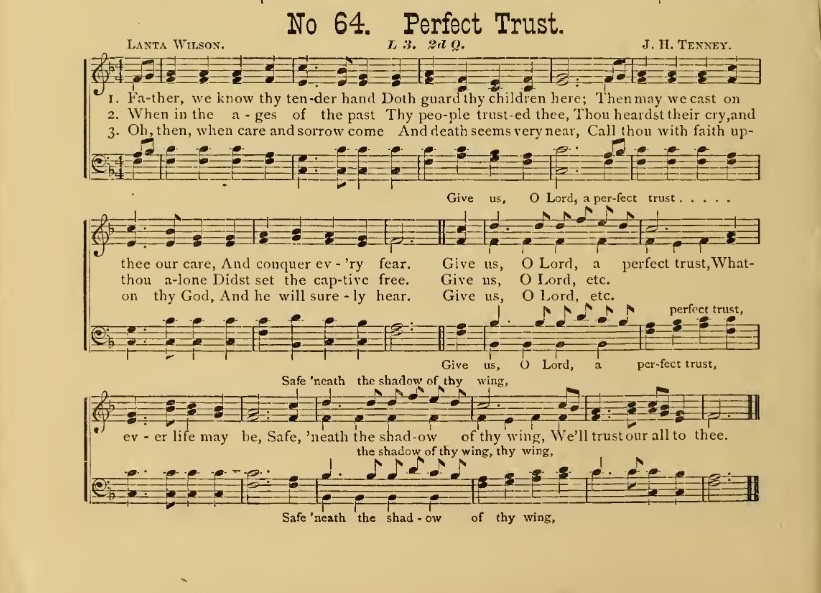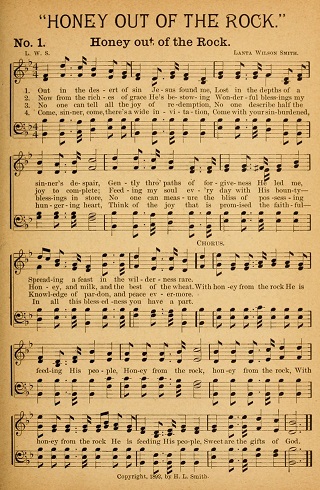
“Scatter Sunshine” has its roots in the late nineteenth-century Gospel Song movement, and is the most widely published hymn from the pen of prolific hymnist Lanta Wilson Smith. It was first published in Edwin Othello Excell’s Triumphant Songs No. 3 (1892), and was borrowed for use by the Latter-day Saints in 1901, when the words were published in the Improvement Era. This hymn was subsequently included in Deseret Sunday School Songs (1909), and secured a place in the official hymnal in 1948. It remains a popular Latter-day Saint hymn today.
The 1985 Latter-day Saint hymnal includes the correct birth and death dates for the composer of the tune, Excell, but no information concerning Smith, who wrote the words. This is due to the fact that, despite biographical entries in both Who’s Who in New England (1909), and Woman’s Who’s Who of America (1915), information concerning Smith’s life was not widely known until 2010, when a short biography written by hymnologist Frank J. Metcalf surfaced online. This biography, originally published in the Choir Herald in March 1947, has since been copied onto several different web sites, including http://www.hymnary.org, the official web site of the Hymn Society in the United States and Canada. Consequently, the years of Smith’s birth and death are now easily found online with a simple internet search, but these have not yet found their way into the current Latter-day Saint hymnal. Unfortunately, Metcalf’s biography of Smith contains several significant errors, including the day of her death and her husband’s middle name, and these have been unknowingly circulated as fact and widely reprinted. The following biography will hopefully correct some of these errors, and paint a more complete picture of the life of Lanta Wilson Smith.

Atlanta Augusta Wilson, or “Lanta” as she was known to her family, was born on July 19, 1856, at Castine, Maine. The youngest of four daughters born to the Reverend William Jones Wilson (1818-1899), a Methodist minster, and his wife Sedelia Abigail (Follett) Wilson (1825-1904), Lanta spent her early childhood in various cities and towns throughout the state of Maine, including Belfast, Wiscasset, Thomaston, Ellsworth, and Surry.
In 1865, due to the poor health of her mother, Lanta’s father was transferred to Wisconsin. In 1866 he moved his family Brohead, Wisconsin, where they remained for two years. At the time of the 1870 United States census the family was living in Fulton, Rock County, Wisconsin.
In 1872, following the “star of empire,” they traveled west to central Nebraska, settling in Dawson County, near the village of Overton. (Buffalo Review). The Wilson family were pioneers in Nebraska in the state’s earliest days. “Her youth with her parents in Nebraska was filled with adventure which she recalled in her later years, when she was invalided by poor health,” according to her obituary in the Taunton (Massachusetts) Daily Gazette. The family stayed in Nebraska for four years, returning to Wisconsin in 1876.
At Shopiere, Wisconsin, Lanta met a young man named Charles Harley Smith, a native of Spring Valley, Wisconsin, whom she married on June 18, 1880. Her husband had aspirations to become a teacher, and entered the State Normal School at Whitewater, Wisconsin, in the fall of that same year, graduating with the class of 1881. He spent one year as Principal of public schools in Rockton, Illinois, and afterward went into business selling school supplies with his father in Parker, Dakota Territory (in present-day South Dakota), where he was concurrently editing the Western Educator, a monthly educational journal, and School Work, a similar paper published in Nebraska. When these two periodicals merged in July 1885 with School Education, a Minnesota educational journal, and continued publication under that name, he remained editor of the Dakota, Nebraska, and Montana departments for another six months.
In late 1885, C. Harley Smith decided to enter the ministry. “On a business trip over the prairies to Lincoln, Neb., his call to the ministry became so definite and imperative that, at Lincoln, he went to a Presiding Elder and made known his conviction and decision,” wrote his colleague, the Reverend Dr. Edward Cary Bass, in 1921, “and immediately was sent further west on a trial trip in preaching, and souls were converted, and our brother no longer ‘conferred with flesh and blood,’ or business.” (Methodist Church, 131).
He became a local preacher in December 1885, and was sent out as a supply pastor to organize a circuit near Plankinton, in the Dakota Territory. “Bro. Smith knew the work on ‘the frontier.’ He knew the prairies when few of the millions of acres had felt the plow share, when the wolf and ‘the rattler’ were not uncommon, when civilization had only begun to make habitations there,” continued Bass. “While yet a ‘supply’ preacher, himself and wife were almost constantly on the road among the eight neighborhoods which he organized as Plankinton Circuit, holding revival meetings for eleven weeks in school houses, with four or five services on many a Sabbath, to save time and meet his appointments eating his lunch as he traveled, and occupying rooms whose walls were thickly frosted.” (Methodist Church, 131).
Lanta, therefore, spent much of her life deeply involved with the ministry. “The daughter of a minister and with an unusual number of ministerial relatives, it is only natural that I should be a minister’s wife,” she later wrote. “I did not inherit pulpit oratory and am perfectly satisfied to do all my preaching with a pen.” (Buffalo Review).
Lanta began writing stories and poems at age sixteen. She later wrote Sunday-school songs, church hymns, and Sunday-school cantatas. “When quite a young girl my entrance into the religious press was made through the Zion’s Herald of Boston,” she explained. “Dr. Bradford K. Pierce, then the editor, was most kind and helpful. The different editors of Sunday-school publications were besieged with my youthful stories and accepted the most of them, often writing me letters of encouragement with the enclosed check. No future successes can ever be so dear as those early ones.” (Buffalo Review).
Her first hymn was published in the International Lesson Hymnal in 1879, when she was twenty-three years old. “My first hymn was written for David C. Cook Publishing Company and was set to music by J. H. Tenney. Its title, ‘Perfect Trust,’ I have tried to make the watchword of my life.”

“From the first I have done a good deal of work for this company [the David C. Cook Publishing Company], chiefly upon order, the latest being a series of Sunday-school anniversary cantatas. Prof. And Mrs. T. Martin Towne, musical and literary editors, respectively, have been exceptionally kind and in many ways have helped me in my literary endeavors. In fact nearly all editors for whom I have written have criticized with kindness and commended generously.” (Buffalo Review).
Lanta Wilson Smith is estimated to have written more than 500 hymns, the most famous of which are “Scatter Sunshine” and “This, Too, Will Pass Away.” Her hymn “Scatter Sunshine” was voted the official song of the International Sunshine Society, an organization whose object was to “incite its members to the performance of kind and helpful deeds, and thus bring the sunshine of happiness into the greatest possible number of hearts and homes.” (Adams).
Among the well-known musicians with whom she collaborated are T. Martin Towne, Edwin O. Excell, Asa Hull, William J. Kirkpatrick and many others. An accomplished musician herself, she sometimes composed the music for her own hymn texts, and occasionally wrote the music for hymn texts by other authors.

Smith was a prolific poet, contributing poems to many different publications including the Inter Ocean, Zion’s Herald, Ram’s Horn, and the Sunday School Journal, to name only a few. Her best-known poem, “This, Too, Will Pass Away,” was first published in the Zion’s Herald on February 4, 1885, and was later set to music with a tune composed by herself. It made its first appearance as a hymn in The Finest of the Wheat, No. 2 (1894). Smith published at least one volume of verse, Wreaths of Remembrance (1905). In addition to her writing, for a time she also edited a Sunshine department in the Church Woman’s Magazine.
Due to the itinerant nature of her husband’s profession, Lanta Smith never lived in any location more than a few years. Her husband was admitted to the Dakota Conference in October 1886, and served in Tyndall until mid-1888, when he transferred to Kimball, and the following year he removed to Plankinton. In 1890 he enrolled as a student at the Garrett Biblical Institute at Evanston, Illinois, and after two years went to Yankton, South Dakota. In 1896 he was transferred to the New England Southern Conference where he served for the next twenty-five years: four years at Phenix and Washington, Rhode Island; two years at Newport, Rhode Island; five years at Taunton, Massachusetts; four years at Brockton, Massachusetts; seven years at New London, Connecticut; and three years at Willimantic and South Coventry, Connecticut.
Early into his third year at Willimantic, Reverend Smith began to experience health problems, and after several months of illness died on February 25, 1921 at Brookline, Massachusetts. After her husband’s death, Lanta Wilson Smith moved to Providence, Rhode Island, where she lived for many years with her son, Elmer, and his family. Around 1929 she was moved to the Attleboro Springs Sanatarium, a nursing home in Attleboro, Massachusetts.
In December 1937, shortly before Attleboro Springs was shut down, Smith removed to Taunton, Massachusetts, where she spent her remaining years. She died in Taunton, Massachusetts on October 18, 1939, and was interred beside her husband at the North Burial Ground Cemetery in Providence, Rhode Island.
Lanta Wilson Smith was the mother of two children: Francis Wilson Smith, born July 26, 1887, died at the age of five-and-a-half years, in November 1892, after a week’s battle with diphtheria; her younger son, Elmer Gold Wilson Smith, was born January 21, 1889 in Kimball, South Dakota, and became a successful voice teacher and choir leader in Providence, Rhode Island. He died October 17, 1976.
As gospel songs have fallen out of favor with modern hymnal editors and compilers, few of Smith’s hymns are still in use. “Scatter Sunshine” can still be found in the current Latter-day Saint hymnal, but it is uncertain if it will be retained in future editions. Unfortunately Smith’s talents as a writer are obscured by the hymn’s optimistic (some might say “trite”) message and the energetic tune. It is hoped that someday her better, lesser-known hymns might be recovered and rediscovered.
The piece for which Lanta Wilson Smith is perhaps best remembered today is “This, too, will pass away,” due to its inclusion (as “This, too, shall pass away”) in the anthology The Best Loved Poems of the American People (1936), edited by Hazel Fellman. The book’s continued success has ensured that this poem has not fallen into obscurity like most of Smith’s other works.
Notes:
*“Scatter Sunshine” also appears in the 1912 edition of the unofficial Latter-day Saint song book the Songs of Zion, but is not in the earlier 1908 edition. The 1908 edition has 246 hymns; the 1912 edition has 269, of which “Scatter Sunshine” is hymn number 247.
*Her earliest pieces were signed “Lanta Wilson” or “Lanta A. Wilson.” After her marriage it was usually “Lanta Wilson Smith” or “Lanta W. Smith,” but occasionally “Mrs. C. H. Smith.”
*Lanta Wilson’s sister, Abbie Ellen Wilson Brown (1850-1907), was also married to a minister, the Rev. Henry Wheaton Brown.
*The Charles Wilson Brown collection of Brown and Wilson family papers, 1846-1967, housed at the John Hay Library, Brown University, includes poems written by Lanta Wilson Smith and other items relating to her and her family. Charles Wilson Brown was a nephew of Lanta Wilson Smith. For more information see the following web address: https://library.brown.edu/riamco/xml2pdffiles/US-RPB-ms97.3.pdf
Biographical sources:
“Joyfully Joined,” Janesville Gazette, June 22, 1880, [3]
Consul Willshire Butterfield, History of Green County, Wisconsin. Together with Sketches of its Towns and Villages, Educational, Civil, Military, and Political History; Portraits of Prominent Persons and Biographies of Representative Citizens (Springfield, Illinois: Union Publishing Company, 1884), 820.
“Southern Dakota,” Daily Press and Dakotaian (Yankton, Dakota Territory), February 19, 1885, [1]
“Minnesota Personal and Otherwise,” School Education, July 1885, 111.
C. Harley Smith, “Dakota Department,” School Education, July 1885, 113.
C. Harley Smith, “Nebraska Department,” School Education, July 1885, 114-115.
School Education, February 1886, 21.
“Personals,” Zion’s Herald, November 30, 1892, 380.
E. O. Excell, Triumphant Songs No. 3 (Chicago: E. O. Excell, 1892), 4.
East Maine Conference (Methodist Episcopal Church), Minutes of the Forty-Ninth Session of the East Maine Conference of the Methodist Episcopal Church 1896, Held in the Methodist Episcopal Church, Old Town, April 15-20, 1896 (Thomaston, Maine, 1896), 92.
Rennetts C. Miller, Souvenir History of the New England Southern Conference, in three volumes, Vol. 3 Providence District (n. p.: Nantasket, Massachusetts, 1897), 248
New England Southern Conference (Methodist Episcopal Church), Year Book of the New England Southern Annual Conference of the Methodist Episcopal Church, Fifty-Ninth Session Held at Provincetown, Mass. April 5-10, 1899 (Providence, Rhode Island: The Providence Press, Snow & Farnham, Printers, 1899), 96.
Henry W. Brown, “Wilson” [Rev. Williams Jones Wilson], Zion’s Herald, July 5, 1899, 866
“The Rev. William J. Wilson,” Christian Advocate, August 24, 1899, 1366.
Ella Celeste Adams, “International Sunshine Society: Its beginning, history, object and methods,” Colorado Springs Gazette, September 16, 1900, 10.
“Scatter Sunshine,” Improvement Era 4, no. 8 (June 1901): 582
“Scatter Sunshine,” Buffalo (New York) Review, November 19, 1902, 6
H. W. Brown, “Wilson” [Mrs. Sedelia Follett Wilson], Zion’s Herald, February 1, 1905, 158
Cleone D. Bergren, “International Sunshine Society (Iowa Division),” Sioux City (Iowa) Journal, February 11, 1906, 14.
Albert Nelson Marquis, Who’s Who in New England: A Biographical Dictionary of Leading Living Men and Women of the States of Maine, New Hampshire, Vermont, Massachusetts, Rhode Island and Connecticut (Chicago: A. N. Marquis & Company, 1909), 861-62.
John William Leonard, ed., Woman’s Who’s Who of America: A Biographical Dictionary of Contemporary Women of the United States and Canada, 1914-1915 (New York: The American Commonwealth Company, 1915), 760.
Methodist Church (U.S.) New England Southern Conference, Year Book of the New England Southern Annual Conference of the Methodist Episcopal Church Eighty-First Session Held at Providence, R. I. April 3-6, 1921 (Providence, Rhode Island: Snow & Farnham Co, 1921), 130-131
Benjamin Tinkham Marshall, A Modern History of New London County, Connecticut (New York: Lewis Historical Publishing Company, 1922), 313.
“Methodist Group Votes Money For Manila Hospital,” New London [Connecticut] Evening Day, December 18, 1937, 13.
“Mrs. Lanta Wilson Smith,” Taunton Daily Gazette, October 18, 1939.
Frank J. Metcalf, “Gospel Hymn-Lover’s Corner,” Choir Herald 50 (March, 1947):150-151.
“Elmer G. W. Smith,” Providence (Rhode Island) Journal, October 19, 1976, B2
“Minutes of the Nebraska Conference”
http://www.usgennet.org/usa/ne/topic/religion/MECHURCH/meconf70/pages/mec74029.htm, accessed May 27, 2019
“Maine Births and Christenings, 1739-1900,” database, FamilySearch (https://familysearch.org/ark:/61903/1:1:F44X-1P8 : accessed 10 July 2005), Atlanta Augusta Willson [sic], 19 Jul 1856; citing CASTINE,HANCOCK,MAINE; FHL microfilm 10,804. [“ Town and Vital Records 1796-1892, Castine Maine”]
Lanta Smith, death certificate No. 558 (Book 18, Page 104), October 18, 1939, Commonwealth of Massachusetts, U. S. A., City of Taunton (Certified by Taunton City Clerk September 20, 2005).
“United States Census, 1860,” databse with images, FamilySearch (https://familysearch.org/ark:/61903/1:1:MDHY-JP6 : 12 December 2017), Alanta [sic] A Wilson in entry for William J Wilson, Thomaston, Knox County, Maine, United States, citing p. 33, family 264, NARA microfilm publication M653 (Washington D.C.: National Archives and Records Administration, n.d.); FHL microfilm 803443.
“United States Census, 1870,” database with images, FamilySearch (https://familysearch.org/ark:/61903/1:1:MNS7-VQM : 12 April 2016), Atlanta Brown [sic] in household of William Wilson, Fulton, Rock County, Wisconsin, United States; citing p. 49, family 382, NARA microfilm publication M593 (Washington D.C.: National Archives and Records Administration, n.d.); FHL microfilm 553,234.
“United States Census, 1880,” database with images, FamilySearch (https://familysearch.org/ark:/61903/1:1:MNHX-4Q3 : accessed 11 November 2005), Lanta Wilson in entry for W J Wilson, Turtle, Rock County, Wisconsin; citing enumeration district ED 199, sheet 404C, NARA microfilm publication T9 (Washington D.C.: National Archives and Records Administration, n.d), roll 1444; FHL microfilm 1,255,444.
“United States Census, 1900,” database with images, FamilySearch (https://familysearch.org/ark:/61903/1:1:M97G-MCC : accessed 11 November 2005), Lanta W Smith in household of C Harley Smith, Newport city Ward 3, Newport, Rhode Island, United States; citing enumeration district (ED) 218, sheet 9B, family 216, NARA microfilm publication T623 (Washington, D.C.: National Archives and Records Administration, 1972.); FHL microfilm 1,241,505.
“United States Census, 1910,” database with images, FamilySearch (https://familysearch.org/ark:/61903/1:1:M2KZ-HQP : accessed 11 November 2005), Lanta W Smith in household of C Harley Smith, Brockton Ward 3, Plymouth, Massachusetts, United States; citing enumeration district (ED) ED 1190, sheet 1B, family 17, NARA microfilm publication T624 (Washington D.C.: National Archives and Records Administration, 1982), roll 611; FHL microfilm 1,374,624.
“United States Census, 1920,” database with images, FamilySearch (https://familysearch.org/ark:/61903/1:1:MCJ9-DRX : accessed 11 November 2005), Lanta Smith in household of Charles H Smith, Willimantic Ward 2, Windham, Connecticut, United States; citing ED 355, sheet 3B, line 91, family 74, NARA microfilm publication T625 (Washington D.C.: National Archives and Records Administration, 1992), roll 198; FHL microfilm 1,820,198.
“Rhode Island State Census, 1925,” database with images, FamilySearch (https://familysearch.org/ark:/61903/1:1:MVWJ-199 : accessed 11 November 2005), Lanta Smith, Providence Ward 02, E.D. 202, Providence, Rhode Island; citing p. 32, line 13, State Archives, Providence; FHL microfilm 1,769,233.